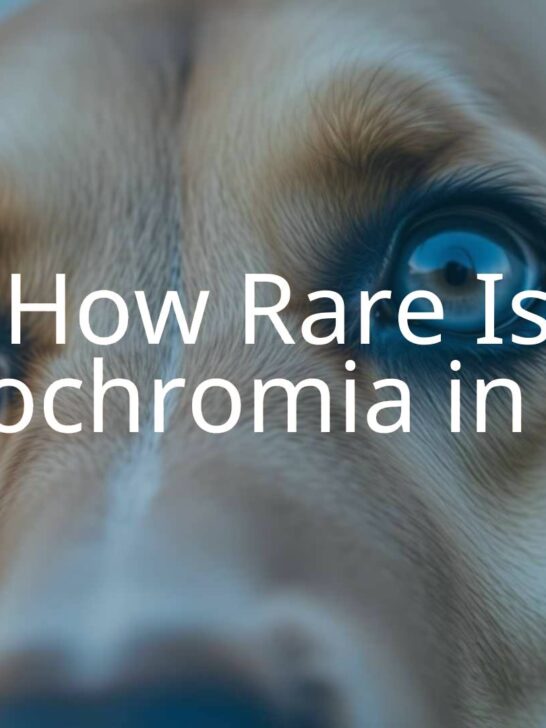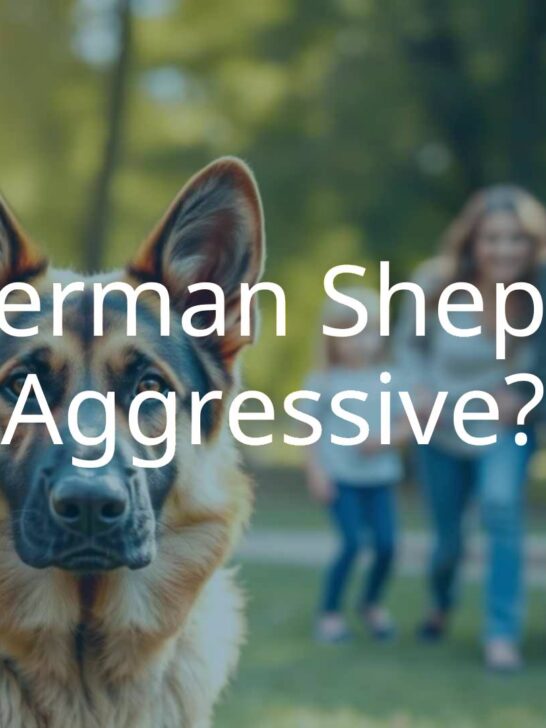Shepadoodle: What Makes the German Shepherd Poodle Mix One of the Best Pets?
Do you know the most common breed used in designer dog mixes? If you guessed Poodle, you would be correct. Now the question is why.
You may think Poodles are desirable for their intelligence, performance skills, and liveliness. While breeders certainly hope to get these qualities, what they most seek from the Poodle is her beautiful and unique hair. Poodle’s fur is like human hair, constantly growing and therefore low shedding.
German Shepherds enjoy their fair share of popularity when it comes to contributing to the gene pool of designer dogs. So what do you get with a German Shepherd Poodle mix?
Once you have seen a Shepadoodle, you will not mistake her again. Shepadoodles have a distinct appearance that Labradoodles, Golden Doodles and Cockapoos also do.
You will acquire a large but compact dog with plenty of energy and intelligence, wavy hair, a highly social demeanor, and engaging and loyal companionship.
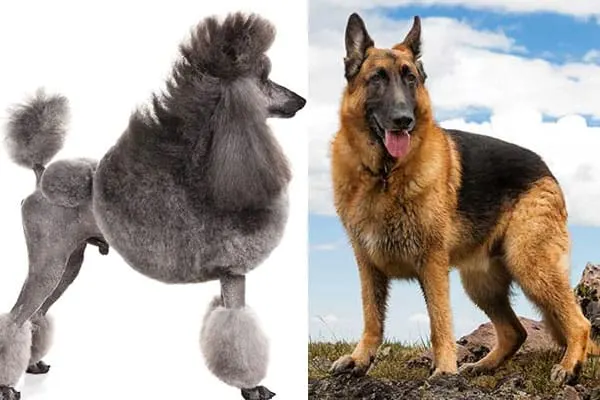
What exactly is a designer dog?
You may hear the phrase designer dog and immediately write the whole subject off as belonging to an exclusive club. The term brings to mind luxury bags and designer jeans.
However, a designer dog simply refers to the result of a founder who attempts to design a dog for specific purposes by harnessing the best features from multiple breeds. There are now so many designer dogs that the purpose of several of them has become lost or forgotten.
Once a designer dog grabs ahold of the imagination of the public, she gets a name that is usually a clever blend of the breeds involved in the mix. Some hybrids have multiple names.
You may be wondering how a designer dog is special when it is just a mongrel. Besides having a different name, designer dogs also have known parentage. In fact, many breeders work as tirelessly on designer dogs as others do on purebred lines.
Some designer canines, like the Labradoodle, may represent several generations of hybrids resulting in increasingly uniform and predictable litters.
What does an F generation mean?
Shepherd Poodle mixes are in high enough demand that some breeders have focused on refining future generations. By back breeding a Shepadoodle to a purebred dog, you can begin selecting for specific traits such as lower shedding or smaller dogs.
Once they start seeing puppies they like, breeders then start mixing hybrids together to further select for specific traits. Similar processes occurred in purebred dogs. Breeding requires four or more generations to start producing consistent results.
- F1 generation – purebred German Shepherd x purebred Poodle; or F1 hybrid x purebred GSD or purebred Poodle is still an F1 dog
- F2 generation – F1 hybrid x F1 hybrid
- F3 generation – F2 hybrid x F2 hybrid
- F4 generation – F3 hybrid x F3 hybrid
You will not likely find many breeders who take the German Shepherd Poodle cross past F3 generation breeding, and F1 breeding is not as common a practice as for other Doodles. The most common advanced mating of the Shepadoodle is the F1 dog bred back to a purebred Poodle.
A breeder, however, may choose to cross a dog at any F generation stage back to a Poodle or German Shepherd to attempt to develop a feature.
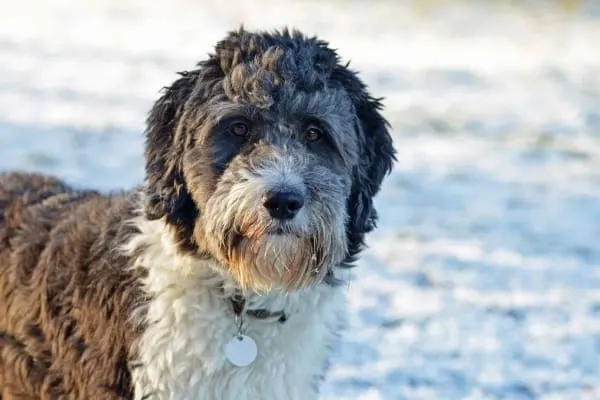
A Shepadoodle Origin Can Tell A Story
German Shepherd
German Shepherds originated from herding dogs who were working in the hills and mountains of Europe around 700 AD.
They did not separate from other herding breeds like the French Shepherd (Berger Picard) and five major Italian herding breeds until 1859.
The GSD would make another huge break in 1892 from the Dutch Shepherd and Belgian Shepherds, which group includes the Belgian Malinois.
However, the German Shepherd did not find its way into an official registry until Max von Stephanitz and his fortuitous discovery of the show dog Hektor in 1899.
Renaming the dog Horand, Stephanitz would go on to mold the breed into a working animal who could do far more than herd sheep.
German Shepherds have such a wide base of desirable qualities like intelligence, obedience, athleticism, and loyalty that they have become one of the most popular dogs worldwide and have retained their status for decades.
Poodle
Poodles may share a common ancestral home with German Shepherds. Regardless of whether they originated from Germany or France, the French were quick to take the Poodle under their wings and develop it into one of the most well-known and popular dog breeds of all time.
Ironically, Poodles are popular everywhere but Paris now and the Doodles have not really caught on either, according to Theloca.fr.
Nevertheless, the commonly shared belief is that Poodles originally served and were developed as working water dogs, specifically to retrieve ducks.
The first poodle-like dogs existed in Egypt and Rome as early as 100 B.C. Their distinctive waterproof curls likely came from the North African Barbet, which gave rise to distinct Barbet types prevalent across Europe, Russia, and Asia.
Although there were Hungarian and French Barbets, historians give credit to the German variety for the Poodle’s current form.
Still, other possible scenarios include herding dogs from Asia developed by nomadic Germanic tribes or Asian Steppe hunting dogs who arrived in France via Portugal.
Also steeped in mystery is when the Poodles start attaining their smaller size variants. The United States started breeding Toy Poodles in the late 1800s, but most believe they emerged at least by the 1400s.
Miniature and Toy Poodles were the results of selectively breeding smaller and smaller dogs together, not from outcrossing. Breeders also use this selective method to attempt to obtain smaller German Shepherd Poodle mixes.
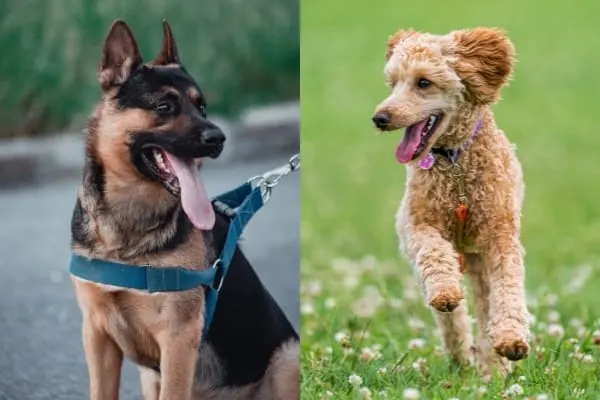
What are the physical traits of a Shepadoodle
The Shepadoodle has among the most recognizable breeds as parents.
What defines the GSD?
German Shepherds are medium or large dogs with upright pointed ears, dark eyes, a pronounced dip between snout and forehead, and a deep chest.
The GSD body is longer than tall at a ratio of about 10:8 depending on the registry. Some working dogs have a square build.
A show German Shepherd has a distinctive slope to his topline. The American Show lines slant from the shoulders to the tail from extreme angulation of the hindlimbs while German show dogs often have a discernable “break” in the line of the vertebrae about the middle of the back. Working German Shepherds have a level and what many argue a more functional topline.
No matter what their profile looks like, Shepherds range from 22 to 26 inches tall at the withers and weigh about 55 to 95 pounds.
There is no weight limit according to the AKC so that some American show dogs can weigh over 100 pounds. Pet-quality dogs originating from these show lines can also be oversized.
The German Shepherd parent can contribute a range of colors to your puppy.
- Black and tan
- Red and tan – West German show lines
- Blue and tan – dilute color, not acceptable to show
- Solid red
- Tan
- Blue/Silver
- Black
- White – not acceptable for show; fanciers have separate shows for White German Shepherds
- Panda – white covers about 30% of the dog; DNA testing proved that panda does not indicate mixed heritage in German Shepherds
- Sable – more common in some working lines; show arenas prefer the more striking black and tan colors
This is a panda GSD, included because the color can be difficult to conceptualize. Not how the Shepherd is an unusual color but has the appropriate breed conformation in every other way. The tail is not curled over the back to indicate any questionable ancestry.
What should a Poodle look like under the hair?
Poodles have a finely-shaped head with prominent but not bugged expressive eyes, a relatively long and delicate snout, and medium-length hanging ears. Poodles have a mild dip in the forehead, but this can look more prominent with a topknot.
Whether sporting a fancy continental haircut or the traditional gundog clip, poodles are square and muscular. They move with grace and athleticism.
There are three size classes, with the largest, the Standard Poodle, the most common contributor to Shepadoodles. They range from over 15 to 20 inches tall and weigh 40 to 60 pounds. Briefly, Miniatures are under 15 inches tall and Toys under 10 inches tall at the shoulders.
Poodles have a large color selection but do not pass many variations along to their German Shepherd offspring.
- Apricot
- Silver
- Parti-colored – white and black or white and brown
- Cream
- Red
- White
- Black
- Brown
- Sable
What does a Shepadoodle take from his parents?
Your dog will have a fairly long but somewhat broader muzzle and forehead than the Poodle. Her ears will be smaller and squarer than a Poodle’s, but they will still hang close to your dog’s head.
Your Shepadoodle will have a mostly square build with slightly longer relative proportions than the Poodle. The tail will probably be rather long and muscular, held up.
Your dog’s color will probably be an almost indescribable blend of shades of gray, brown, black, and red.
Shepadoodles are often sable but can also be solid cream, tan, or black, according to Thedogdigest.com. Some are black and tan, but their markings do not exhibit quite the same striking lines as the German Shepherd’s patterns. Many are an indistinct patchwork of brown and gray.
At first glance, a Shepadoodle may even resemble a terrier mix to you. However, you will notice a certain noble set of the head and shape of the eyes that are unique to the Shepadoodle hybrid.
How Could You Describe Shepadoodle’s Trainability and Intelligence?
Both the German Shepherd and Poodle rank in the top three most intelligent dogs. Since psychologist Stanley Coren’s ranking system takes into consideration obedience and working intelligence as well as adaptability and instincts, it also suggests the GSD and Poodle are highly trainable.
Your Shepadoodle should be smart as a whip and take readily to education. The work ethic of the German Shepherd makes him thoroughly enjoy pleasing you if you can effectively stimulate his mind.
You may have to use your imagination to keep training interesting for a Shepherd. Puzzle games can be a valuable tool until your Shepherd figures them out. Activities that require your GSD to problem solve are best to ward off boredom.
Poodles also need mental challenges but are less likely to become bored with training as long as you keep it about them.
Poodles enjoy problem-solving as much as German Shepherds but enjoy attention and validation. Positive reinforcement is vital for both breeds although not necessarily in the form of food.
Your GSD Poodle should be incredibly smart and trainable. Occasionally you may stumble with dominance issues from the Shepherd side and sensitivity from the Poodle, but for the most part a firm, self-assured, and positive approach will give you an engaged dog who is a joy to be around.
What is the watchdog potential?
Remember when Beware of Dog signs commonly had a German Shepherd’s profile on them? German Shepherds still have a reputation as one of the most effective guard breeds.
- Large intimidating appearance
- Deep-throated, loud and formidable bark
- Fast-charging dog
- Agile, able to jump and scale fences and walls
- Fearless
Poodles can be almost as much of a deterrent for criminal trespass because none of them are quiet. Even small poodles are alarmists with a loud and persistent bark to announce visitors and intruders alike.
- Will not quiet down until they have caught the attention of the owner
- Provoked poodles have a sharp bite
If you have a German Shepherd Poodle mix, she will be an excellent watchdog. She may inherit a small or moderate amount of guarding instinct of the GSD or be largely nonaggressive, more like the Poodle. Either way, she will be sure to warn you of any unwelcome activity around your home or family.
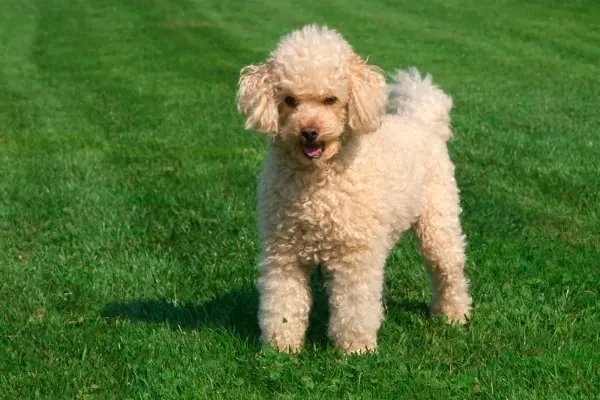
The German Shepherd, especially from working lines, can be suspicious of strangers and is not given to easy or indiscriminate shows of affection.
Even within a family, Shepherds may bond more strongly with one member over the others. Deep-seated wariness can become aggression in some Shepherds, especially if you do not spend a significant amount of time socializing with your puppy.
A German Shepherd can sometimes be aggressive around other dogs. Some trainers report females in particular exhibit same-sex hostility.
According to Yourpurebredpuppy.com, Standard Poodles are generally friendly to moderately reserved with guests they do not know. Most Poodles will warm to people if given enough time.
- com ranks Poodles as the second friendliest dog with strangers. However, there are family lines that produce timid or shy dogs who cower and even snap. Allegedly, poor breeding caused Poodles to fall out of favor in France, producing stereotypical ankle biters and prima donnas.
Your Shepadoodle will most likely be friendly to your guests if a little distant upon the first introduction. Shepadoodles will warm to strangers more quickly if allowed to do so on their own terms. As with any dog, socialization is key to having a well-adjusted and friendly dog.
Socialize your Shepadoole young, and he will enjoy meeting and playing with other dogs. The best way to avoid dogfights is to expose your puppy to a variety of situations and other canids, so he learns proper communication skills and how to be comfortable.
You should learn the skill of reading canine body language as well so you can keep your pet out of potentially harmful situations.
Shepadoodles may exhibit prey aggression against smaller animals. Shepherd Poodle mixes can inherit a strong prey drive from either the herding or hunting backgrounds of their parents.
Will Shepadoodle Grooming Be Time-consuming?
German Shepherds usually have a dense double coat that you must brush to keep clean and to decrease moderate to severe shedding that is normal with the breed.
Poodles contributed greatly to modern grooming, starting the trend for elaborate haircuts that complimented their owners during the Victorian Age. All Poodle types require daily brushing at a minimum. Their curls can snarl and become matted or unruly.
Show Poodles must exhibit a standard cut in the ring while pets often receive a simple generalized clipping, called a sport, puppy, or kennel cut. Most owners find short hair more manageable than long cords or curls.
Your hybrid of the GSD and Poodle is likely to have medium fur that may have waves. If you acquire a second-generation dog or one who was the result of a crossbreed back to a Poodle, your dog may have finer fur with more defined waves. Most of the time they require brushing, but the majority stay natural or receive a body clip.
Shepadoodles may require you to pay extra attention to their faces. They can inherit a Poodle tendency to stain along the tracts leading from their eyes. Stains are, of course, much more visible on light-colored dogs.
Do not forget the weather
While German Shepherds are equipped with a coat to withstand temperatures that dip below freezing, Poodles have a single layer of hair. They can suffer if the temperature approaches even 40 degrees Fahrenheit.
However, Poodles have a waterproof coat that benefits them when swimming, and as long as they are active, they can stay warm. Standard Poodles do better than miniature and toy varieties because their larger size does not allow heat to escape so rapidly.
Your German Shepadoodle will have a variable coat, but most will have at least a thin undercoat and semi-waterproof outer fur. Your dog will not be able to handle temperatures as cold as a purebred Shepherd would but should do reasonably well in water.
Poodles are adept swimmers but not all like water, so your mix may or may not enjoy wading pools or lakes.
For the most part, avoid cold weather unless your dog is exercising. Consider putting a jacket on your Shepadoodle if the temperature is near freezing.
What about the heat?
German Shepherds, surprisingly, tolerate warm weather conditions very well. Their undercoat is effective at trapping cooler air near the skin like a continual breeze.
Poodles have a thin single-layer coat that you may think keeps them cool, but it also leaves them a little vulnerable to burning from the sun.
If you have a Shepadoodle, do not subject her to prolonged exposure to temperatures above 80 to 85 degrees Fahrenheit.
Also, consider a Shepadoodle will always do worse when the humidity is high, just like you. Make ake sure your dog has ready access to shade, so if she has a thin or absent undercoat she will not experience the ill-effects of direct sunlight on her exposed skin.

Is German Shepherd Poodle Mix Health Reasonably Good?
When it comes to the health of mixed-breed dogs, there are two schools of thought. One set believes hybridization improves mostly by increasing the gene pool and reducing some exaggerated characteristics such as the squash faces of Bulldogs.
The other general feeling is that a hybrid has just as much chance to inherit genetic problems as purebreds.
The following points are pertinent.
- Many hybrids between certain breeds show improvement over their pedigreed counterparts, but not enough data exists to know if this is true for the majority of cases. One example that stands out is the elimination of a specific type of urinary bladder stones in a population of Dalmatians by outcrossing with English Pointers.
- The passage of some traits depends on their dominance. For example, if a roached back or a snub nose is a dominant trait, at least 50% of the offspring will inherit it if only one parent shows the characteristic. Incomplete dominance could allow modification of a trait.
Short legs on a Boston Terrier might lengthen moderately by breeding to a long-legged Irish Wolfhound, for example.
Shepadoodles are probably most susceptible to the problems German Shepherds and Poodles commonly pass on.
- Hypothyroidism – (both) The thyroid gland does not produce enough hormones. Common signs are sluggishness, weight gain, skin problems, and a dull coat.
- Bloat (both) – More common in the Standard Poodle than the smaller varieties, bloat is life-threatening stomach distension that also occurs with regularity in German Shepherds.
- Addison’s disease (Standard Poodle) – The adrenal glands do not produce steroidal hormones that the dog needs for water regulation and to deal with stress.
- Elbow dysplasia (GSD) – Elbow develops abnormalities that make the joint uneven during a puppy’s growth.
- Hip dysplasia (GSD, all Poodles) – Abnormal development of the hip joint
- Progressive retinal atrophy (Poodles) – Affected dogs can eventually go blind.
- Hypoglycemia (Poodles) – A disorder whereby the blood sugar reaches dangerously low levels. It can be prevalent especially in Toy dogs.
- Epilepsy (Both)- Seizure disorder where the cause remains unknown.
- Degenerative myelopathy (GSD) – A progressive disorder that affects the nervous system. Degenerative myelopathy is painless but devastating just the same.
- Intravertebral disc disease (GSD) – More commonly called a slipped disc or IVDD, this involves the breakdown of the vertebrae leaving the discs susceptible to injury and nerve impingement. Affected dogs can become paralyzed, especially in the hind end.
- Pancreatitis (Both) – German Shepherds and Poodles are both overrepresentations of canine pancreatitis. Individuals who have repetitive bouts can be more prone to developing diabetes.
- Diabetes (Both) – Diabetes in most dogs is insulin-dependent and not linked to metabolic syndromes like humans and cats.
Your Shepadoodle will probably be most vulnerable to hip and elbow dysplasia, disc disease, bloat, pancreatitis, and thyroid abnormalities.
Summary
The Shepadoodle is a medium to a large, compact dog about 20 to 28 inches tall at the shoulders and weighing 50 to 120 pounds.
Occasionally if a breeder uses a toy Poodle and a small GSD, the result could be a dog that is only 15 inches tall and weighs 30 to 40 pounds.
Expect your hybrid to have brown, soulful eyes rounder than a German Shepherd’s. His fur be will be medium in length with waves and little in the way of an undercoat. His most common color will be sable.
Finally, your German Shepadoodle will have a healthy wariness of strangers, be loyal to your family, play well with kids and other dogs, and be intense but smart and easy to train. She will excel at agility, search and rescue, therapy, swimming, and physical assistance.
When you first glance at this dog you are struck by what looks like a predominantly Poodle-type.
However, you can see Shepherd in the head, tail carriage, and the way the dog moves. Note this Shepadoodle is black, not an uncommon color for the mix, and is compact with a slightly longer body received from the GSD.
This dog’s curls may indicate a Shepherd Poodle cross that someone back bred to a Poodle.














